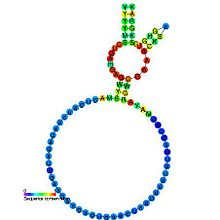Hammerhead ribozyme
| Hammerhead ribozyme HH9 | |
|---|---|

Predicted secondary structure and sequence conservation of the HH9 ribozyme found conserved from lizard to human genomes
|
|
| Identifiers | |
| Symbol | HH9 |
| Rfam | RF02275 |
| Other data | |
| RNA type | Gene; ribozyme |
| Domain(s) | Eukaryota |
| SO | 0000380 |
| Hammerhead ribozyme (type I) | |
|---|---|

Predicted secondary structure and sequence conservation of Hammerhead_1
|
|
| Identifiers | |
| Symbol | Hammerhead_1 |
| Rfam | RF00163 |
| Other data | |
| RNA type | Gene; ribozyme |
| Domain(s) | Viroids; Eukaryota |
| SO | 0000380 |
| Hammerhead ribozyme (type III) | |
|---|---|

Predicted secondary structure and sequence conservation of Hammerhead ribozyme (type III)
|
|
| Identifiers | |
| Symbol | Hammerhead_3 |
| Rfam | RF00008 |
| Other data | |
| RNA type | Gene; ribozyme |
| Domain(s) | Viroids; Eukaryota |
| SO | 0000380 |
The hammerhead ribozyme is a RNA molecule motif that catalyzes reversible cleavage and joining reactions at a specific site within an RNA molecule. It serves as a model system for research on the structure and properties of RNA, and is used for targeted RNA cleavage experiments, some with proposed therapeutic applications. Named for the resemblance of early secondary structure diagrams to a hammerhead shark, hammerhead ribozymes RNAs were originally discovered in two classes of plant virus-like RNAs: satellite RNAs and viroids. They have subsequently been found to be widely dispersed within many forms of life.
The self-cleavage reactions, first reported in 1986, are part of a rolling circle replication mechanism. The hammerhead sequence is sufficient for self-cleavage and acts by forming a conserved three-dimensional tertiary structure.
In the natural state, a hammerhead RNA motif is a single strand of RNA, and although the cleavage takes place in the absence of enzymes, the hammerhead RNA itself is not a catalyst in its natural state, as it is consumed by the reaction and cannot catalyze multiple turnovers.
Trans-acting hammerhead constructs can be engineered such that they consist of two RNA strands. The strand that gets cleaved can be supplied in excess, and multiple turnover can be demonstrated and shown to obey Michaelis-Menten kinetics, typical of protein enzyme kinetics. Such constructs are typically employed for in vitro experiments, and the term "hammerhead RNA" has become in practice synonymous with the more frequently used "hammerhead ribozyme".
The minimal trans-acting hammerhead ribozyme sequence that is catalytically active consists of three base-paired stems flanking a central core of 15 conserved (mostly invariant) nucleotides, as shown. The conserved central bases, with few exceptions, are essential for ribozyme’s catalytic activity. Such hammerhead ribozyme constructs exhibit in vitro a turnover rate (kcat) of about 1 molecule/minute and a Km on the order of 10 nanomolar.
...
Wikipedia
